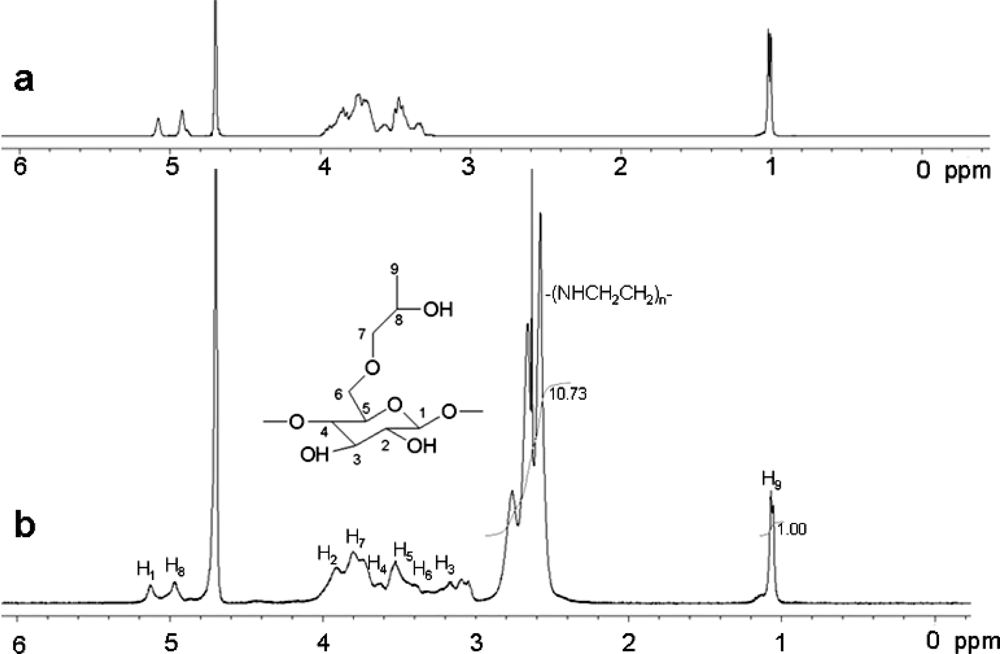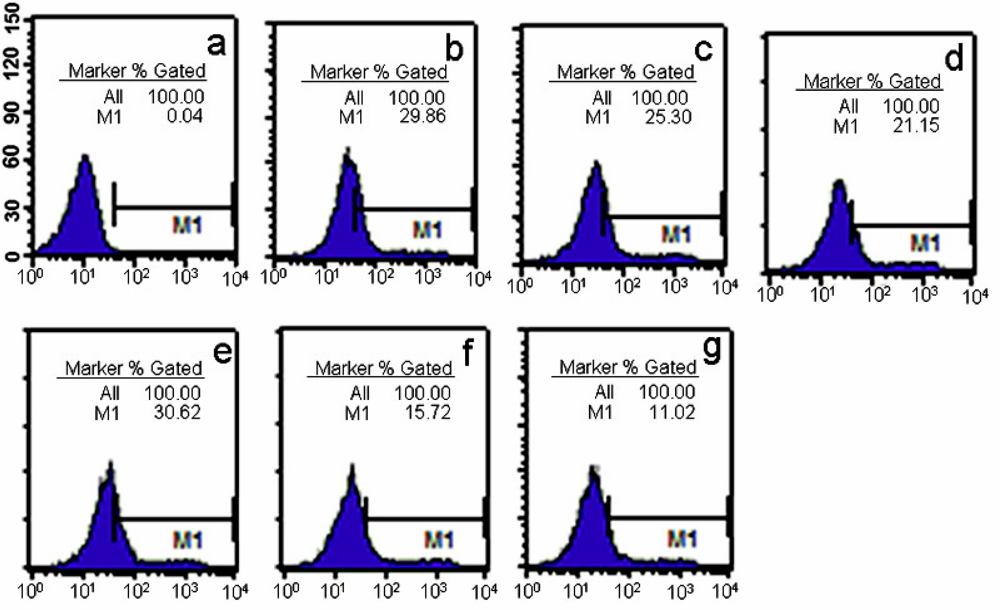A Novel Co-polymer Based on Hydroxypropyl α-Cyclodextrin Conjugated to Low Molecular Weight Polyethylenimine as an in Vitro Gene Delivery Vector
Abstract
:1. Introduction
2. Results and Discussion
2.1. 1H-NMR of the co-polymer
2.2. Particle size and zeta potential test
2.3. Agarose gel electrphoresis assay
2.4. Cell viability assay
2.5. In vitro gene delivery by co-polymer/DNA complexes
3. Experimental Section
3.1. Materials and cells
3.2. Plasmid preparation
3.3. 1H-NMR Measurements
3.4. Particle size and zeta potential test
3.5. Agarose gel electrphoresis assay
3.6. Cell viability assay
3.7. Transfection efficiency with luciferase assay
3.8. Transfection efficiency with fluorescence microscope
3.9. Flow cytometry analysis
3.10. Statistics analysis
4. Conclusions
Acknowledgments
References and Notes
- Thomas, CE; Ehrhardt, A; Kay, MA. Progress and problems with the use of viral vectors for gene therapy. Nat. Rev. Genet 2003, 4, 346–358. [Google Scholar]
- Neu, M; Fischer, D; Kissel, T. Recent advances in rational gene transfer vector design based on poly(ethylene imine) and its derivatives. J. Gene Med 2005, 7, 992–1009. [Google Scholar]
- Godbey, WT; Wu, KK; Mikos, AG. Size matters: Molecular weight affects the efficiency of poly(ethylenimine) as a gene delivery vehicle. J. Biomed. Mater. Res 1999, 45, 268–275. [Google Scholar]
- Kunath, K; von Harpe, A; Fischer, D; Petersen, H; Bickel, U; Voigt, K; Kissel, T. Low-molecular-weight polyethylenimine as a non-viral vector for DNA delivery: Comparison of physicochemical properties, transfection efficiency and in vivo distribution with high-molecular-weight polyethylenimine. J. Control Rel 2003, 89, 113–125. [Google Scholar]
- Ahlemeyer, B; Fischer, D; Kissel, T; Krieglstein, J. Staurosporine-induced apoptosis in cultured chick embryonic neurons is reduced by polyethylenimine of low molecular weight used as a coating substrate. Neurosci. Res 2000, 37, 245–253. [Google Scholar]
- Petersen, H; Kunath, K; Martin, AL; Stolnik, S; Roberts, CJ; Davies, MC; Kissel, T. Star-shaped poly(ethylene glycol)-block-polyethylenimine copolymers enhance DNA condensation of low molecular weight polyethylenimines. Biomacromolecules 2002, 3, 926–936. [Google Scholar]
- Davis, ME; Brewster, ME. Cyclodextrin-based pharmaceutics: Past, present and future. Nat. Rev. Drug Discov 2004, 3, 1023–1035. [Google Scholar]
- Gonzalez, H; Hwang, SJ; Davis, ME. New class of polymers for the delivery of macromolecular therapeutics. Bioconjug. Chem 1999, 10, 1068–1074. [Google Scholar]
- Cheng, J; Khin, KT; Jensen, GS; Liu, A; Davis, ME. Synthesis of linear, beta-cyclodextrin-based polymers and their camptothecin conjugates. Bioconjug. Chem 2003, 14, 1007–1017. [Google Scholar]
- Pun, SH; Bellocq, NC; Liu, A; Jensen, G; Machemer, T; Quijano, E; Schluep, T; Wen, S; Engler, H; Heidel, J; Davis, ME. Cyclodextrin-modified polyethylenimine polymers for gene delivery. Bioconjug. Chem 2004, 15, 831–840. [Google Scholar]
- Forrest, ML; Gabrielson, N; Pack, DW. Cyclodextrin-polyethylenimine conjugates for targeted in vitro gene delivery. Biotechnol. Bioeng 2005, 89, 416–423. [Google Scholar]
- Arima, H; Kihara, F; Hirayama, F; Uekama, K. Enhancement of gene expression by polyamidoamine dendrimer conjugates with alpha-, beta-, and gamma-cyclodextrins. Bioconjug. Chem 2001, 12, 476–484. [Google Scholar]
- Kihara, F; Arima, H; Tsutsumi, T; Hirayama, F; Uekama, K. In vitro and in vivo gene transfer by an optimized alpha-cyclodextrin conjugate with polyamidoamine dendrimer. Bioconjug. Chem 2003, 14, 342–350. [Google Scholar]
- Xiong, MP; Laird Forrest, M; Ton, G; Zhao, A; Davies, NM; Kwon, GS. Poly(aspartate-g-PEI800), a polyethylenimine analogue of low toxicity and high transfection efficiency for gene delivery. Biomaterials 2007, 28, 4889–4900. [Google Scholar]
- Tang, GP; Guo, HY; Alexis, F; Wang, X; Zeng, S; Lim, TM; Ding, J; Yang, YY; Wang, S. Low molecular weight polyethylenimines linked by beta-cyclodextrin for gene transfer into the nervous system. J. Gene Med 2006, 8, 736–744. [Google Scholar]
- Yang, C; Li, H; Goh, SH; Li, J. Cationic star polymers consisting of alpha-cyclodextrin core and oligoethylenimine arms as nonviral gene delivery vectors. Biomaterials 2007, 28, 3245–3254. [Google Scholar]
- Huang, H; Tang, G; Wang, Q; Li, D; Shen, F; Zhou, J; Yu, H. Two novel non-viral gene delivery vectors: Low molecular weight polyethylenimine cross-linked by (2-hydroxypropyl)-beta-cyclodextrin or (2-hydroxypropyl)-gamma-cyclodextrin. Chem. Commun. (Camb) 2006, 22, 2382–2384. [Google Scholar]
- Kilsdonk, EP; Yancey, PG; Stoudt, GW; Bangerter, FW; Johnson, WJ; Phillips, MC; Rothblat, GH. Cellular cholesterol efflux mediated by cyclodextrins. J. Biol. Chem 1995, 270, 17250–17256. [Google Scholar]
- Neufeld, EB; Cooney, AM; Pitha, J; Dawidowicz, EA; Dwyer, NK; Pentchev, PG; Blanchette-Mackie, EJ. Intracellular trafficking of cholesterol monitored with a cyclodextrin. J. Biol. Chem 1996, 271, 21604–21613. [Google Scholar]
- Zhao, Q; Temsamani, J; Agrawal, S. Use of cyclodextrin and derivatives as carriers for oligonucleotide delivery. Antisense Res 1995, 5, 185–192. [Google Scholar]
- Arima, H; Kihara, F; Hirayama, F; Uekama, K. Enhancement of gene expression by polyamidoamine dendrimer conjugates with α-, β-, and γ -cyclodextrins. Bioconjugate. Chem 2001, 12, 476–484. [Google Scholar]
- Lawrencia, C; Mahendran, R; Esuvaranathan, K. Transfection of urothelial cells using methyl-β-cyclodextrin solubilized cholesterol and Dotap. Gene Ther 2001, 8, 760–768. [Google Scholar]









© 2008 by MDPI This article is an open-access article distributed under the terms and conditions of the Creative Commons Attribution license (http://creativecommons.org/licenses/by/3.0/).
Share and Cite
Huang, H.; Yu, H.; Li, D.; Liu, Y.; Shen, F.; Zhou, J.; Wang, Q.; Tang, G. A Novel Co-polymer Based on Hydroxypropyl α-Cyclodextrin Conjugated to Low Molecular Weight Polyethylenimine as an in Vitro Gene Delivery Vector. Int. J. Mol. Sci. 2008, 9, 2278-2289. https://doi.org/10.3390/ijms9112278
Huang H, Yu H, Li D, Liu Y, Shen F, Zhou J, Wang Q, Tang G. A Novel Co-polymer Based on Hydroxypropyl α-Cyclodextrin Conjugated to Low Molecular Weight Polyethylenimine as an in Vitro Gene Delivery Vector. International Journal of Molecular Sciences. 2008; 9(11):2278-2289. https://doi.org/10.3390/ijms9112278
Chicago/Turabian StyleHuang, Hongliang, Hai Yu, Da Li, Yang Liu, Fenping Shen, Jun Zhou, Qingqing Wang, and Guping Tang. 2008. "A Novel Co-polymer Based on Hydroxypropyl α-Cyclodextrin Conjugated to Low Molecular Weight Polyethylenimine as an in Vitro Gene Delivery Vector" International Journal of Molecular Sciences 9, no. 11: 2278-2289. https://doi.org/10.3390/ijms9112278



